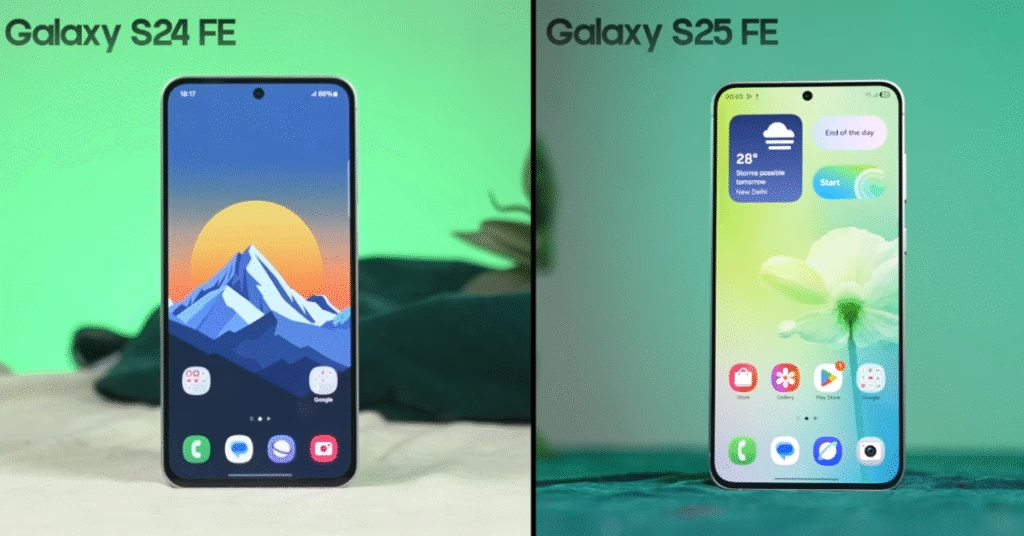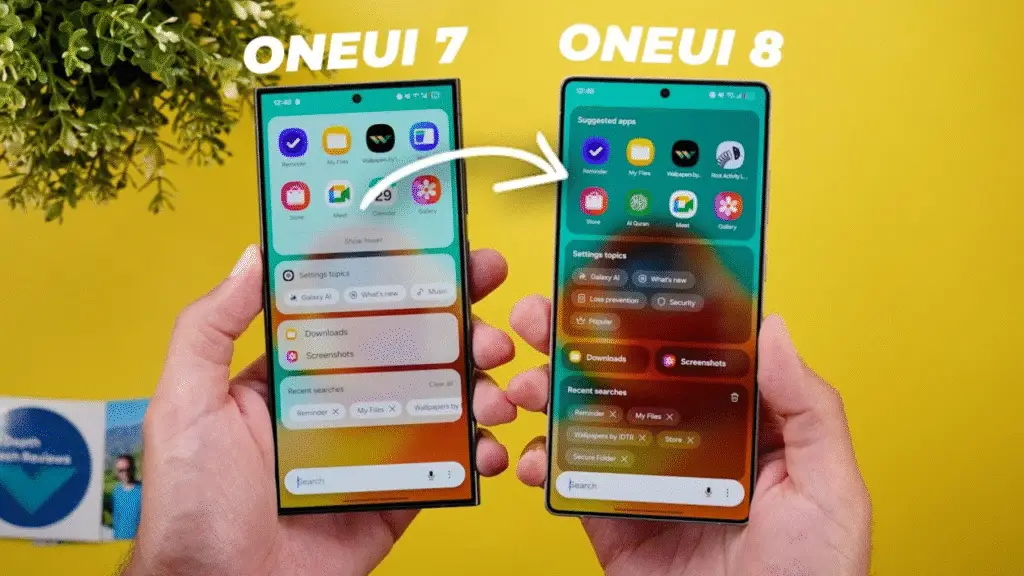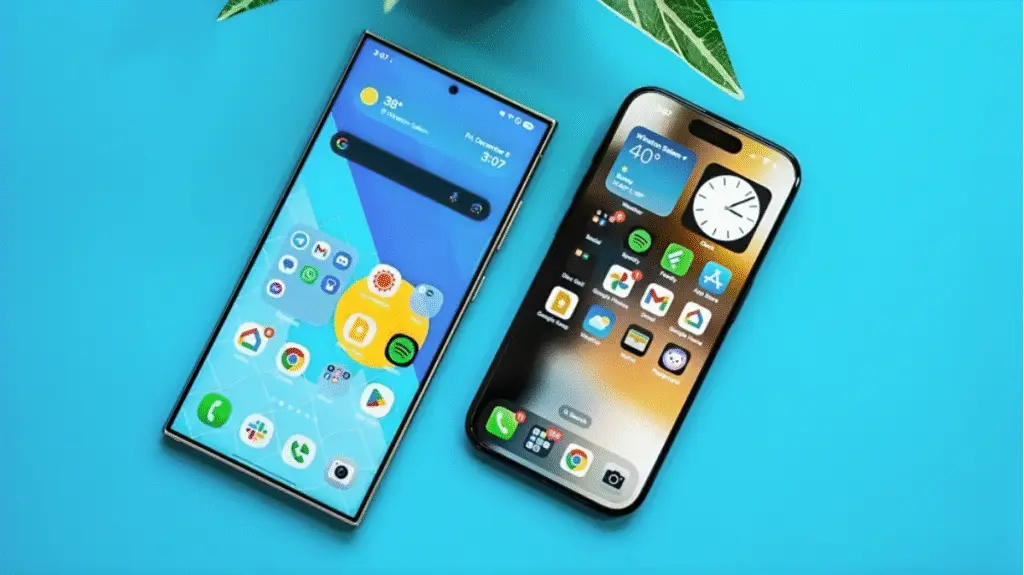
When Samsung released the Galaxy S24 FE last year, it quickly became one of the best value picks in the company’s lineup. Now with the arrival of the Galaxy S25 FE, the question on everyone’s mind is simple: is it worth upgrading, or should you grab the discounted S24 FE instead?
I’ve spent time with both devices side by side, and in this review, I’ll break down the real differences you’ll notice in day-to-day use. Instead of just rattling off specs, I’ll share what actually matters if you’re trying to decide between the two.
Design and Build
At first glance, the two phones look almost identical. Both carry the familiar Samsung design language with flat sides, clean lines, and a premium glass-and-metal build. But the moment you pick them up, you notice something different.
The S25 FE is slimmer and lighter, shaving off 0.66 mm in thickness and 23 grams in weight compared to its predecessor. It doesn’t sound like much on paper, but it’s enough to make the phone feel more comfortable during long use.
Color options are slightly refreshed too. While the S24 FE came in classic tones, the newer model introduces two shades of blue alongside black and white. Small touches, but enough to keep the lineup fresh.
That said, overall durability and materials are basically unchanged. Both have glass on the front and back with an aluminum frame, so you won’t feel like you’re getting a sturdier device with the newer model.
Quick Comparison
| Specification | Galaxy S24 FE | Galaxy S25 FE |
|---|---|---|
| Display | 6.7″ AMOLED, 120Hz | 6.7″ LTPO OLED, 120Hz, brighter |
| Chipset | Exynos 2400 (underclocked) | Exynos 2400 (full version) |
| RAM / Storage | 8GB / 128GB, 256GB, 512GB | 8GB / 128GB, 256GB, 512GB |
| Main Camera | 50MP + 12MP ultra-wide + 8MP telephoto | Same as S24 FE |
| Front Camera | 10MP | 12MP (improved) |
| Battery | 4,700mAh, 25W charging | 4,900mAh, 45W charging |
| Build | Glass front (Gorilla Glass Victus+), glass back (Gorilla Glass Victus+), aluminum frame | Glass front (Gorilla Glass Victus+), glass back (Gorilla Glass Victus+), aluminum frame |
| Weight | 209g | 186g |
| Software Support | 6 years of updates | 6 years of updates |
| Launch Price | $599 (now discounted) | $699 (launch price) |
Disclaimer: Specs and prices may vary by region. Always confirm with official sources.
Display
The display is still a 6.7-inch OLED with 120Hz refresh rate, but Samsung has made a key upgrade that’s easy to miss. The S25 FE uses LTPO technology, which allows the screen to drop its refresh rate dynamically. In practice, this means better battery efficiency because the screen doesn’t always run at full 120Hz.
Brightness is another big difference. The newer model is about 36% brighter at peak levels, and you really notice this outdoors. If you spend a lot of time under sunlight, the S25 FE offers a much clearer and more comfortable viewing experience.
The bezels are just a touch slimmer too, though the bottom chin still looks slightly chunky compared to premium flagships. Not a dealbreaker, but worth mentioning.
Camera: Mostly the Same Story
Here’s where things start to feel repetitive. Samsung has reused the same rear camera system from the S24 FE, and in fact, it’s the same setup from the S23 FE as well. That means you’re getting decent quality, solid processing, and reliable results, but nothing new on the hardware front.
The only actual change is with the front camera. The S25 FE bumps it up to 12 megapixels, the same selfie shooter used in the flagship Galaxy S25 series. Selfies are a little sharper and clearer, especially in good lighting, but the difference isn’t dramatic enough to justify an upgrade on its own.
In short: if you were hoping for a big leap in photography, you won’t find it here.
Performance: A Mixed Bag
This is one area where I had high expectations but walked away a bit disappointed. Back when Samsung first introduced the Fan Edition line, the idea was to give users flagship-level performance at a slightly lower price. That strategy has shifted.
The S24 FE ran on an underclocked Exynos 2400, which was already a step down from the main flagship chips. With the S25 FE, Samsung uses the full Exynos 2400 from last year’s flagship series. On paper, this sounds like a good move, but in real-world use, the performance gap compared to this year’s flagships is still huge.
Even compared directly to the S24 FE, the difference is barely noticeable. Apps load at roughly the same speed, and gaming performance feels nearly identical. Multitasking doesn’t get any smoother either because Samsung stuck with 8GB of RAM and didn’t increase the base storage options.
So while the newer model technically has a stronger chip, the real-world gain is minimal.
Battery and Charging
This is where Samsung finally delivers something meaningful. The S25 FE packs a 4,900mAh battery, which is larger than the S24 FE and matches the Galaxy S25 Plus. Combine that with LTPO screen efficiency, and you get noticeably better endurance.
On top of that, the phone now supports 45W fast charging, a big step up from last year’s 25W. In daily use, this means you can top up your battery much faster, making the S25 FE a more reliable companion if you’re often on the go.
This is easily the most practical and user-friendly upgrade between the two models.
Software and Updates
Both devices are guaranteed six years of Android updates, which is a huge plus. Samsung has been doing a great job keeping its software polished with One UI, and both phones feel very similar in everyday use.
That means even if you go for the older model, you’re not losing out on long-term support. This levels the playing field quite a bit when deciding which phone to buy.
Price and Value
Here’s where things really matter. The S25 FE is the shiny new release, but the S24 FE is now heavily discounted. Since the core experience between the two is almost identical apart from the brighter display and bigger battery the older model simply offers better value.
For most people, the S24 FE will give you the same day-to-day performance, the same cameras, and the same long software support, but at a much lower cost. Unless you really need brighter outdoor visibility or faster charging, the newer phone doesn’t justify paying the full launch price.
Final Verdict: Which One Should You Buy?
After using both phones, here’s my honest take:
- Go for the S25 FE if you want the best possible battery life, faster charging, and slightly brighter display. It’s the more refined version, even if the upgrades are subtle.
- Choose the S24 FE if you want to save money and still enjoy a nearly identical experience. With discounts, it’s hard to beat the value it offers right now.
Both phones are solid mid-range picks, but when it comes to S25 FE vs S24 FE, the smarter choice for most people is the older model. You get all the essentials, long software support, and a price that makes it feel like a real deal.
See Also Samsung S25 FE Review: Lighter Build, Bigger Battery, Better Value
FAQs
Is the Galaxy S25 FE worth upgrading from the S24 FE?
Not for most people. The differences are mainly a brighter LTPO display, slightly lighter design, bigger battery, and faster charging. If you already own the S24 FE, the upgrade feels minor.
Does the S25 FE have better cameras than the S24 FE?
No major changes. The rear cameras are the same as last year. The only improvement is the selfie camera, which is now 12MP instead of 10MP.
Which one has better performance, the S25 FE or S24 FE?
On paper, the S25 FE uses a stronger chip, but in daily use the difference is very small. Apps, games, and multitasking feel nearly identical.
How much bigger is the S25 FE’s battery compared to the S24 FE?
The S25 FE comes with a 4,900mAh battery, slightly larger than the S24 FE. It also supports faster 45W charging, which makes a bigger real-world difference.
Which phone is better value for money right now?
The S24 FE. With heavy discounts available, it delivers almost the same experience as the S25 FE while costing less. Unless you need the brighter screen or faster charging, the S24 FE is the smarter buy.



